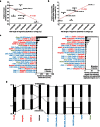An ethnically relevant consensus Korean reference genome is a step towards personal reference genomes
- PMID: 27882922
- PMCID: PMC5123046
- DOI: 10.1038/ncomms13637
An ethnically relevant consensus Korean reference genome is a step towards personal reference genomes
Erratum in
-
Corrigendum: An ethnically relevant consensus Korean reference genome is a step towards personal reference genomes.Nat Commun. 2017 Oct 9;8:16168. doi: 10.1038/ncomms16168. Nat Commun. 2017. PMID: 28991236 Free PMC article.
Abstract
Human genomes are routinely compared against a universal reference. However, this strategy could miss population-specific and personal genomic variations, which may be detected more efficiently using an ethnically relevant or personal reference. Here we report a hybrid assembly of a Korean reference genome (KOREF) for constructing personal and ethnic references by combining sequencing and mapping methods. We also build its consensus variome reference, providing information on millions of variants from 40 additional ethnically homogeneous genomes from the Korean Personal Genome Project. We find that the ethnically relevant consensus reference can be beneficial for efficient variant detection. Systematic comparison of human assemblies shows the importance of assembly quality, suggesting the necessity of new technologies to comprehensively map ethnic and personal genomic structure variations. In the era of large-scale population genome projects, the leveraging of ethnicity-specific genome assemblies as well as the human reference genome will accelerate mapping all human genome diversity.
Conflict of interest statement
The authors declare no competing financial interests.
Figures



Similar articles
-
KOREF_S1: phased, parental trio-binned Korean reference genome using long reads and Hi-C sequencing methods.Gigascience. 2022 Mar 24;11:giac022. doi: 10.1093/gigascience/giac022. Gigascience. 2022. PMID: 35333300 Free PMC article.
-
KoVariome: Korean National Standard Reference Variome database of whole genomes with comprehensive SNV, indel, CNV, and SV analyses.Sci Rep. 2018 Apr 4;8(1):5677. doi: 10.1038/s41598-018-23837-x. Sci Rep. 2018. PMID: 29618732 Free PMC article.
-
Birth of an 'Asian cool' reference genome: AK1.BMB Rep. 2016 Dec;49(12):653-654. doi: 10.5483/bmbrep.2016.49.12.195. BMB Rep. 2016. PMID: 27881215 Free PMC article.
-
The Human Pangenome Project: a global resource to map genomic diversity.Nature. 2022 Apr;604(7906):437-446. doi: 10.1038/s41586-022-04601-8. Epub 2022 Apr 20. Nature. 2022. PMID: 35444317 Free PMC article. Review.
-
New Approaches for Genome Assembly and Scaffolding.Annu Rev Anim Biosci. 2019 Feb 15;7:17-40. doi: 10.1146/annurev-animal-020518-115344. Epub 2018 Nov 28. Annu Rev Anim Biosci. 2019. PMID: 30485757 Review.
Cited by
-
Nationwide genetic analysis of more than 600 families with inherited eye diseases in Argentina.NPJ Genom Med. 2023 May 22;8(1):8. doi: 10.1038/s41525-023-00352-1. NPJ Genom Med. 2023. PMID: 37217489 Free PMC article.
-
Comparative analysis of 7 short-read sequencing platforms using the Korean Reference Genome: MGI and Illumina sequencing benchmark for whole-genome sequencing.Gigascience. 2021 Mar 12;10(3):giab014. doi: 10.1093/gigascience/giab014. Gigascience. 2021. PMID: 33710328 Free PMC article.
-
KOREF_S1: phased, parental trio-binned Korean reference genome using long reads and Hi-C sequencing methods.Gigascience. 2022 Mar 24;11:giac022. doi: 10.1093/gigascience/giac022. Gigascience. 2022. PMID: 35333300 Free PMC article.
-
An integrated Asian human SNV and indel benchmark established using multiple sequencing methods.Sci Rep. 2020 Jun 17;10(1):9821. doi: 10.1038/s41598-020-66605-6. Sci Rep. 2020. PMID: 32555294 Free PMC article.
-
Misassembly of long reads undermines de novo-assembled ethnicity-specific genomes: validation in a Chinese Han population.Hum Genet. 2019 Jul;138(7):757-769. doi: 10.1007/s00439-019-02032-6. Epub 2019 Jun 5. Hum Genet. 2019. PMID: 31168775
References
Publication types
MeSH terms
Grants and funding
LinkOut - more resources
Full Text Sources
Other Literature Sources

